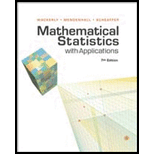
a.
Find the marginal density
Identify the densities.
a.
Answer to Problem 25E
The marginal density function for
Explanation of Solution
Calculation:
Consider that
Then, the marginal probability functions of
Hence, the marginal probability density function for
Thus, the marginal density function for
In similar way, the marginal probability density function for
Thus, the marginal density function for
Gamma function:
A random variable Y is said to follow a Gamma distribution with parameter
Where
Hence, comparing with the probability density function of Gamma function the marginal density function for
b.
Find the values of
b.
Answer to Problem 25E
The value of both
Explanation of Solution
From Part (a), marginal density function for
Hence,
Thus,
From Part (b), marginal density function for
Hence,
Thus,
c.
Find the values of
c.
Answer to Problem 25E
The values of
Explanation of Solution
Calculation:
Conditional distribution and density function:
Consider that
Now, the conditional distribution function of
Now, for any
Similarly, for any
In the given problem the range of both
Hence, the values of
d.
Find the conditional density function of
d.
Answer to Problem 25E
The conditional density function of
Explanation of Solution
Calculation:
Using the joint probability density function of
Hence, the conditional density function of
e.
Find the conditional density function of
e.
Answer to Problem 25E
The conditional density function of
Explanation of Solution
Calculation:
Using the joint probability density function of
Hence, the conditional density function of
f.
Compare the marginal density function
f.
Explanation of Solution
From Part (d), conditional density function of
From Part (a), the marginal density function for
Hence,
Thus, it can be said that
g.
Explain the meaning of the answer in Part (f) regarding the implication of the marginal and conditional probabilities that
g.
Explanation of Solution
From Part (f), it is obtained that
Hence, it can be said the marginal probability of
Want to see more full solutions like this?
Chapter 5 Solutions
Mathematical Statistics with Applications
 Linear Algebra: A Modern IntroductionAlgebraISBN:9781285463247Author:David PoolePublisher:Cengage Learning
Linear Algebra: A Modern IntroductionAlgebraISBN:9781285463247Author:David PoolePublisher:Cengage Learning
